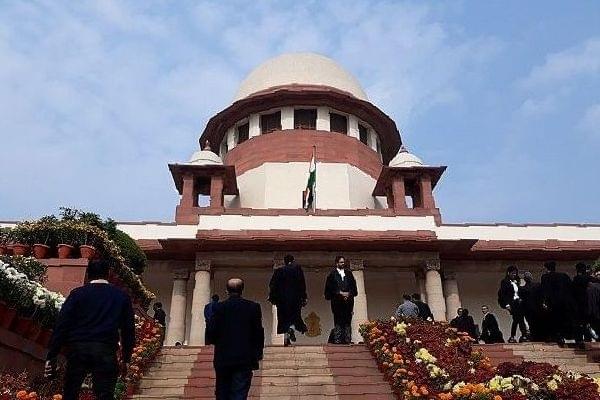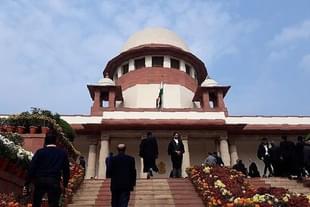Politics
SC Collegium Is Opaque And Past Sell-By Date, But Critics Who Junked NJAC Have No Right To Complain
R Jagannathan
Sep 13, 2019, 04:56 PM | Updated 04:56 PM IST
Save & read from anywhere!
Bookmark stories for easy access on any device or the Swarajya app.


There has been much criticism of the Supreme Court collegium’s recent decision to transfer several senior judges – Chief Justice Vijaya Tahilramani of the Madras High Court to Meghalaya and her replacement with the Meghalaya Chief Justice A K Mittal – both by former judges and members of various bar associations (read here, and here).
The transfer of CJ Tahilramani from a larger court to a minuscule one was rightly seen by her as a demotion, and she offered her resignation soon after. The transfers involved other state high courts too, and advocates’ associations in Tamil Nadu, Guwahati and Telangana have been protesting against these “arbitrary” and “opaque” decisions.
Retired Justice Madan Lokur, who was one of the four Supreme Court judges who addressed a press conference in January 2018 citing arbitrary functioning by the then Chief Justice Dipak Misra, has since written an article in The Economic Times criticising the collegium’s decisions.
He wrote: “A senior and eminently competent judge from one high court has been transferred out supposedly for the better administration of justice, giving an impression that his presence in the high court was not conducive to the administration of justice… A senior and equally competent judge in another high court has been transferred, again for the better administration of justice… What takes the cake is the transfer of the chief justice of a chartered high court to a much, much smaller high court. While all high courts are equal and equally respected, this transfer lacked grace and whatever the reason (and there must be a good one) it is ex-facie suggestive of humiliation and she has done well to resign… The mystery behind the change in the appointment of the chief justice from one high court to another will need a Sherlock Holmes to unravel.”
Justice Lokur also criticised the method of selecting judges by the collegium: “There are no fixed criteria for selection of judges to the Supreme Court and the requirements keep changing. There are considerations of seniority, adequate representation of high courts, gender, religion, caste and, of course, merit sometimes finds a place as well. A new criterion has recently been introduced: Who will be the Chief Justice of India, for how long and who should be blocked. Is it possible to rid this Chancellor’s Foot syndrome? Last week, two senior judges of the SC objected to overlooking seniority while recommending appointments to the SC.”
Responding to the criticism, both from within its own judicial fraternity and from legal luminaries, Supreme Court Secretary General Sanjeev S Kalgaonkar issued a strong rebuttal, saying the transfers were done for “cogent reasons”.
He said: “Each of the recommendations for transfer was made for cogent reasons after complying with the required procedure in the interest of better administration of justice. Though it would not be in the interest of the institution to disclose the reasons for the transfer(s), if found necessary, the collegium will have no hesitation in disclosing the same.”
Given the widespread criticism and protests among advocates in the high courts affected by the transfers, maybe the collegium should indeed disclose its reasons.
However, the critics forget one thing: no matter how transparently the collegium functions, the original sin relates to the court’s decision to become its own appointing authority. No judiciary in the world has the last word in who gets to become judge. In most countries these decisions are either taken by independent commissions set up by the executive or by legislatures themselves (as in the US).
Only in India did the Supreme Court decide to act as judge in a case it was itself an interested party, and a five-judge constitution bench headed by J S Khehar junked the unanimously-approved National Judicial Appointments Commission (NJAC).
The NJAC was the first legislative attempt to take judicial appointments outside the exclusive domain of the collegium and move it to a panel where both the chief justice and the executive would have a say, and with both having an effective veto, even if through proxies. Over time, this mechanism could have been fine-tuned to create more transparency in appointments and transfers.
Madan Lokur, one of the current critics of the collegium, was one of the judges in the constitutional bench that rejected the NJAC. He, of all people, cannot now complain that the collegium is acting arbitrarily on appointments and transfers. Why didn’t he fix the problem at source when he had a change on the constitution bench, instead of reinstating the same arbitrariness he is now attacking?
It is perhaps time for Parliament to get back to the agenda of creating a neutral institution to pick, transfer and remove judges, but after informal consultations with the higher judiciary. The original sin of rejecting the NJAC needs to be atoned for.
Jagannathan is former Editorial Director, Swarajya. He tweets at @TheJaggi.





